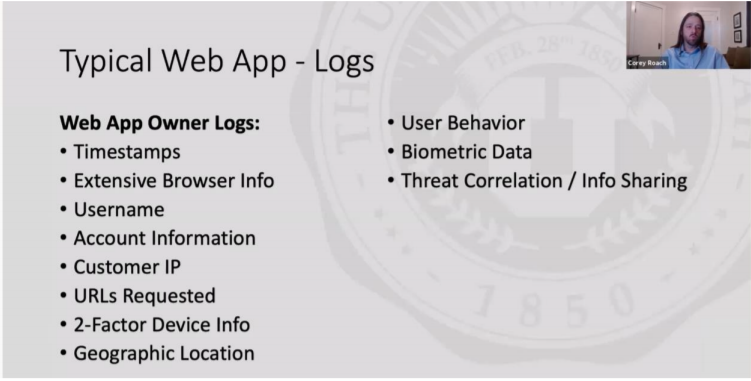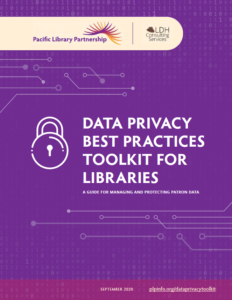
Library ethics, privacy, and technology collided again last week, this time with the publication of issue 52 of the Code4Lib Journal. In this issue, the editorial committee published an article describing an assessment process with serious data privacy and ethical issues and then explained their rationale for publishing the article in the issue editorial. The specifics of these data privacy and ethical issues will not be covered in-depth in this week’s newsletter – you can read about said issues in the comment section of the Code4Lib Journal article in question.
You might have noticed that we said “again” in the last paragraph. This isn’t the first time library technology publications and patron privacy collided. The Code4Lib Journal published a similarly problematic article last year, but the journal is one of many library scholarship venues that have published scholarly and practical literature that are ethically problematic with regard to patron privacy. Technology and assessment are the usual offenders, ranging from case studies of implementing privacy-invasive technologies to research extolling the benefits of surveilling students in the name of learning analytics without discussing the implications of violating student patron privacy. These publications are not set up as a point-counterpoint exploration of these technologies and assessment methods in terms of privacy and ethics. Instead, these publications are entered into the scholarly record as is, with an occasional contextual note or superficial sentence or two about privacy. Retraction is almost unheard of in library scholarship, and retraction is not very effective in addressing problematic research.
Library scholarship is not consistently aligned with the profession’s ethical standards to uphold patron privacy and confidentiality. Whether or not an article is judged on its potential impact on library privacy is currently up to the individual peer reviewer (or in the case of editor-reviewed journals such as Code4Lib, the editor). In addition, library scholarship is not set up to assess the potential privacy risks and harms of the publication in question to specific patron groups, particularly patrons from minoritized populations. Currently, there is no suitable mechanism to do such an assessment that can be included in the original publication so that it would be both meaningful and informative to the reader. We are left with publications in the library scholarship record that promote the uncritical adoption of high-risk practices that go against professional ethics and harm patrons. This becomes more perilous when these publications come across those in the field who do not have the knowledge or experience in assessing these publications with patron privacy and ethics in mind.
What we end up with, therefore, is a scholarly record full of information hazards. An information hazard is a particular piece of information that can potentially cause harm to the knower or create the potential to harm others. This differs from misinformation where the information being spread is false, whereas the truthfulness of the information hazard is intact. Nick Bostrom’s seminal work on information hazards breaks down the specific risks and harms of different types of hazards. Library scholarship has (at least) two information hazards in particular when it comes to library privacy and ethics:
Idea hazard – Ideas hold power. They also come with risks. Even if the dissemination of an idea is kept at a high level without specific details, it can become an idea hazard. The idea that a library can use a particular system or process to assess library use can risk patron privacy. There are ways to mitigate an idea risk of this nature, including evaluating the assessment idea through the Five Whys method or other methods to determine the root need for such an assessment.
Development hazard – A development hazard is when advancement in a field of knowledge leads to technological or organizational capabilities that create negative consequences. Like other fields of technology, library technology falls into this hazard category, particularly when combined with the evolution of library assessment practices and norms. Sharing code and processes (which is a data hazard) can lead to community or commercial development of more privacy-invasive library practices if no care is taken to mitigate patron privacy risks.
How, then, can library scholarship become less of a privacy information hazard? First and foremost, the responsibility falls on the publishers, editors, peer reviewers, and conference program organizers who control what is and is not added to the library scholarly record. This includes creating a code of ethics for submission authors to follow and guidelines for reviewers and editors to follow to assess the privacy and ethical implications of the submission. However, these codes and guidelines are not effective if they are not acted upon. As Dorothea Salo says, “Research on library patrons that contravenes library-specific ethics is unethical; it should not be published in the LIS literature, and when published there, should be retracted.” Regardless of the novelty or other technical merits of the submission, if the submission violates or goes against library ethics or privacy standards, the editors, reviewers, and publishers have the responsibility as shapers of the scholarly record to not publish the submission lest they add yet another information hazard to the record.
Library privacy and ethics must also be a part of every stage of the submission and publication process. This takes a page from Privacy by Design, taking a proactive approach to privacy instead of rushing to include privacy at the last minute, making any privacy effort ineffective at best. Ethical codes and guidelines are one way to embed privacy into a process; another is to include checkpoints in the process to bring in external subject matter experts to review submissions well in advance to identify or comment on specific privacy or ethical risks. If done early in the submission process, the information received can then be used to revise the submission to address these issues or to change the focus of the submission to one that is more appropriate to address the privacy and ethical implications of the topic at hand. The submission itself doesn’t have to be abandoned, but it must be constructed so that the privacy and ethical risks are front and center, describing why this method, idea, process, or code goes against library ethics and privacy. This option doesn’t eliminate the idea/data hazard, but shifting the focus on privacy and ethical repercussions can mitigate the risks that come with such hazards.
Whether intentional (as in the case of the latest Code4Lib Journal issue) or unintentional, library scholarship places patron privacy at risk through the unrestricted flow of information hazards. Many in the profession face pressure to create a constant stream of scholarship, but at what cost to our patrons’ privacy and professional ethics? A scholarly record full of privacy information hazards has and will continue to have long-lasting implications for the profession’s ability to protect patron privacy as well as how well we can serve everyone in the community (and not just those who have a higher tolerance for privacy risks or won’t be as negatively impacted by poor privacy practices). As the discussion about the Code4Lib Journal’s decision to publish the latest information hazard into the scholarly record continues, perhaps the community can use this time to push for more privacy and ethically-aligned submission and review processes in library scholarship.





